
Maribor is the second-largest city in Slovenia and the largest city of the traditional region of Lower Styria. It is the seat of the Urban Municipality of Maribor and the Drava statistical region. Maribor is also the economic, administrative, educational, and cultural centre of eastern Slovenia.

Oberwesel is a town on the Middle Rhine in the Rhein-Hunsrück-Kreis (district) in Rhineland-Palatinate, Germany. It belongs to the Verbandsgemeinde Hunsrück-Mittelrhein, whose seat is in Emmelshausen.

Closeburn Castle is a privately owned tower house, probably of the 14th century, but possibly older, and is one of the oldest continually inhabited houses in Scotland. The castle is located 1 km east of the village of Closeburn, in the historical county of Dumfriesshire, 2 km south-east of Thornhill, in Dumfries and Galloway, Scotland.
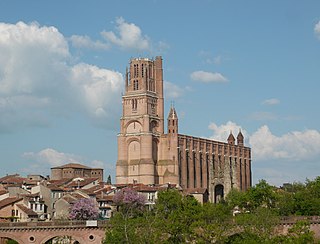
The Cathedral of Saint Ceciliaof Albi, also known as Albi Cathedral, is the seat of the Catholic Archbishop of Albi. First built in the aftermath of the Albigensian Crusade, the grim exterior resembles a fortress, but the interior is lavishly decorated with art and sculpture, a very ornate choir screen, and walls in bright blues and golds, in the Toulousian or Southern French Gothic style. It was begun in 1282 and was under construction for 200 years. It is claimed to be the largest brick building in the world. In 2010 the cathedral, along with its episcopal buildings, was designated a UNESCO World Heritage Site because of its unique architecture and the remarkable consistency in its design.

Dunasead Castle, sometimes known as Baltimore Castle, is a 17th-century fortified house situated in the town of Baltimore in County Cork, Ireland. The tower house is built on the site of an earlier Norman-era structure, which itself replaced an earlier Bronze Age ringfort. Traditionally associated with the chiefs of clan O'Driscoll, the castle was purchased and restored by members of the McCarthy family in the late 1990s, and partially opened to the public from 2005.

Ljubljana Castle is a castle complex standing on Castle Hill above downtown Ljubljana, the capital of Slovenia. It is a key landmark of the town. Originally a medieval fortress, it was probably constructed in the 11th century and rebuilt in the 12th century. It acquired its present outline with an almost complete overhaul in the 15th century, whereas the majority of the buildings date to the 16th and 17th centuries. Initially a defense structure and since the first half of the 14th century the seat of the lords of Carniola, it was since the early 19th century used for various other purposes and today is used as a major cultural venue.

Hellenstein Castle is located 70 meters (230 ft) above the city of Heidenheim an der Brenz in eastern Baden-Württemberg, Germany. It was once the home of the Lords of Hellenstein.

The Maribor Water Tower is a medieval fortified tower in the city of Maribor, Slovenia. The late-Renaissance tower stands directly abuts the Drava River and dates from 1555. It is of pentagonal form and consists of massive stone blocks interspersed with embrasures. It was built to secure the southeast part of the Maribor city walls from the direction of the river.
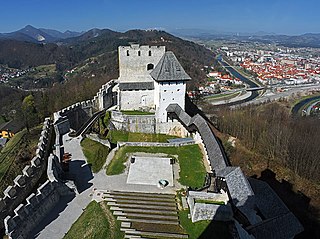
Celje Castle, also known as Celje Upper Castle or Old Castle, is a castle ruin in Celje, Slovenia, formerly the seat of the Counts of Celje. It stands on three hills to the southeast of Celje, where the river Savinja meanders into the Laško valley. Today, the castle is in the process of being restored. It was once the largest fortification on Slovenian territory.

Jamestown Church, constructed in brick from 1639 onward, in Jamestown in the Mid-Atlantic state of Virginia, is one of the oldest surviving building remnants built by Europeans in the original Thirteen Colonies and in the United States overall. It is now part of Historic Jamestown, and is owned by Preservation Virginia. There have been several sites and stages in the church's history, and its later tower is now the last surviving above-ground structure from the days when Jamestown was the capital of Virginia. The current structure, active as part of the Continuing Anglican movement, is still in use today. The ruins are currently being researched by members of the Jamestown Rediscovery project.

Račji Dvor Mansion is a 17th-century mansion standing on a plain at the western edge of the town of Maribor, Slovenia, at the address of Raški dol 1. It has been protected as a cultural monument of national significance.

Strmol Mansion is a 15th-century manorhouse located on a low hill above the old town center of Rogatec, Slovenia. It is notable as one of the few castles in Slovenia to have retained a Slovene name throughout its history.

Samtavro Monastery is a Georgian Orthodox Christian monastery complex that combines Samtavro Transfiguration Church and Nunnery of St. Nino in Mtskheta, Georgia. Built presumably in the 4th century by the King Mirian III, and reconstructed in the 11th century by the King George I and Catholicos-Patriarch Melchizedek I, Samtavro is an important Early and High Medieval historical and architectural monument, and was inscribed on the UNESCO World Heritage List in 1994 along other historical monuments in Mtskheta. Samtavro church is cross-in-square temple, with arches and other decorations typical for the 11th century Georgian architecture. The graves of Mirian III and the famous Georgian Saint monk Gabriel are located in the yard of Samtavro Church.

The Volčji Potok Arboretum was opened to the public in 1952. It originally formed part of the Souvan family estate in 1885, which was taken over by the University of Ljubljana in 1952 and legally declared a place of cultural and natural heritage of national importance. Now independent of the university, it is the most visited botanical garden in Slovenia and in recent years has become well known for its spring flower shows. The arboretum is primarily a botanical garden for woody plants, the only one in Slovenia.
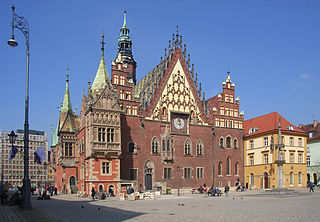
The Old Town Hall of Wrocław stands at the center of the city’s Market Square (rynek). The Gothic town hall built from the 13th century is one of the main landmarks of the city.
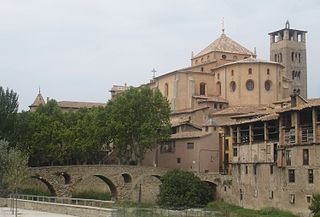
Vic Cathedral, officially the Cathedral of St. Peter the Apostle, is a Roman Catholic cathedral in Vic, Catalonia, Spain. It is the seat of the Diocese of Vic.
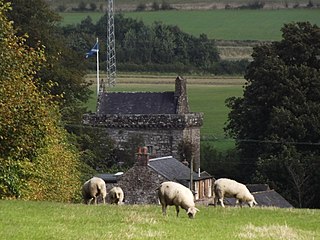
Bonshaw Tower is an oblong tower house, probably dating from the mid-16th century, one mile south of Kirtlebridge, Dumfries and Galloway, Scotland, above the Kirtle Water. It is adjacent to a 19th-century mansion. The tower was one of a number of structures built along the Scottish border in the 1500s as protection against incursions by the English.

Athlumney Castle is a tower house and fortified house and a National Monument in Navan, Ireland.

The Church of St Vincent in Newnham in Hertfordshire is a 12th-century Anglican parish church and a Grade II* listed building, having gained that status in 1968. The church is named for Saint Vincent and is under the Diocese of St Albans; it is noted for the Newnham Murals which were uncovered in 1963.

The Zemo Nikozi church of the Deity, also known as Ghvtaeba (ღვთაება), is a medieval Georgian Orthodox cathedral in the Gori Municipality, in Georgia's east-central region of Shida Kartli. It is part of the complex which also includes a bell-tower, an episcopal palace, and a circuit wall. The complex is inscribed on the list of Georgia's Immovable Cultural Monuments of National Significance.






















